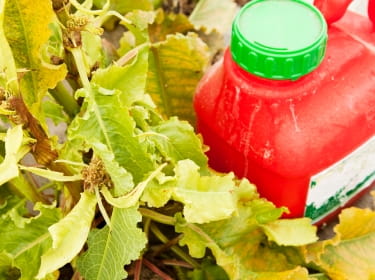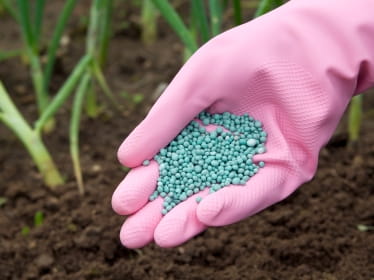Lawn Chemicals How to Protect Yourself from Potential Poisonings

The Bottom Line
Spring can be a tough season for lawns. Homeowners sometimes use chemicals to repair winter damage and prepare the lawn for summer's rain, drought, or heat. If you decide to use chemicals to treat your lawn, choose only those chemicals which will treat your specific problem. Handle and store them safely.

The Full Story
Spring can be a tough season for lawns. Homeowners sometimes use chemicals to repair winter damage and prepare the lawn for summer's rain, drought, or heat.
Many lawn problems can be addressed by modifying the soil, growing conditions, type of grass seed, and routine care provided. If you decide to use chemicals to treat your lawn, choose only those chemicals which will treat your specific problem. Purchase only as much as you'll need. Store products safely, out of reach of children and pets.
When you use lawn care chemicals, follow label directions carefully to avoid harming yourself, children, pets – and, of course, the environment. Here is a list of common lawn products used in the spring.
Lime is used to alter the soil pH, if a soil test shows that the soil is too acidic to sustain a lawn. Lime is applied in a dry or granular form. Use it when there is no wind, as the powder can irritate your eyes, nose, and throat if it blows into your face. Be sure to keep it dry, as wet lime can burn your skin. If lime does blow into your eyes or face, brush off as much as you can. Then, immediately run a lot of water over your face and skin. A shower works well, but a hose might be handier. Then call Poison Control (800-222-1222).
Fertilizer can be irritating if it gets into your eyes, nose, or mouth. It can cause stomach upset if swallowed. Usually, there are no other problems with the types of fertilizers sold for home use. BUT – and this is a big "but" – some fertilizer products also contain weed killers and insecticides.
Herbicides, or weed killers, may contain a number of ingredients, including carbamates and glyphosate. Getting these products on the skin or in the eyes is likely to cause irritation. Inhaling them can cause lung irritation. The greatest danger is from swallowing them; this has happened when products were transferred into unlabeled containers or into beverage containers. Children and adults have been seriously poisoned in this way.
In addition to the active weed-killing ingredients, herbicides often contain ingredients intended to help them spread evenly or stick to plant leaves. These ingredients are labeled "inert" because they don't kill weeds, but they can still be harmful if swallowed or inhaled.
Insecticides may be used to kill grubs that damage grass, ticks, and fleas. Biological control agents such as nematodes are not harmful to humans. Some other types of insecticides can be absorbed through skin or inhaled; of course, they can also be swallowed if not stored safely. Poisoning symptoms could range from mild stomach upset to seizures, depending on the ingredients.
Apply insecticides on a day with no wind. Cover as much skin area as possible with long sleeves, long pants, and gloves. Be sure that children and pets aren't around.
The bottom line is that lawn care chemicals intended for homeowner use can be used safely when label directions are followed carefully and products are stored properly. To avoid skin, eye, throat, and lung irritation, use these products on days with little or no wind. Avoid the risk of swallowing them by storing these products in original, labeled containers. If they must be diluted in different containers, label those containers clearly and do NOT use them for any other purpose. Lock the products and containers up high, out of sight and reach of children and pets.
If someone gets a lawn care chemical on their skin or in their eyes, rinse with running water for 15-20 minutes. Then, use the webPOISONCONTROL® tool for guidance online or call Poison Control at 1-800-222-1222. If someone swallows one of these products, get guidance from Poison Control right away, either online or by phone.
Feel free to call Poison Control at 1-800-222-1222 if you have questions about the safety of lawn care chemicals you're planning to use. Poison specialists can answer them, whether you plan to apply products yourself or have a professional lawn care company treat your lawn.
Rose Ann Gould Soloway, RN, BSN, MSEd, DABAT emerita
Clinical Toxicologist
Poisoned?
Call 1-800-222-1222 or
Prevention Tips
Purchase only as much product as you'll need. Store products safely, out of reach of children and pets. When you use lawn care chemicals, follow label directions carefully to avoid harming yourself, children, pets - and, of course, the environment.
This Really Happened
Case 1: A 36-year-old man used lime on his lawn. The following day, he noticed redness on both of his shins. The reddened areas were also itchy. He called Poison Control for advice.
Poison Control gave him advice for how to treat the possible skin burn from the lime. He was advised to wash the affected areas daily, apply antibiotic ointment and to seek medical evaluation and treatment if the redness did not improve or if it worsened.
When Poison Control called to follow-up on the patient about one week later, the redness had resolved.
Case 2: A 21-year-old man was inadvertently sprayed in the eye with an herbicide applied by a landscaper. Poison Control was called about the patient when he presented to the emergency room with pain in his eye. The product contained the herbicide glyphosate, which can cause chemical burns.
Poison Control provided initial treatment recommendations, including irrigation, and discussed examining the patient's eye for corneal burns.
The patient was evaluated by an eye doctor and the exam revealed corneal burns. He was treated with antibiotics applied in the eye.
Case 3: A 2-year-old child drank a very toxic pesticide. Her father had brought it home from work and stored it in an open cup in a bathroom cabinet. It was a carbamate insecticide - a highly toxic pesticide typically available in high concentrations for commercial use by pest control operators. Carbamate insecticides affect the brain and cause life-threatening symptoms.
The child vomited 15 minutes after she drank the carbamate insecticide. She quickly became very drowsy and her father could not keep her awake. He called 911. The 911 operator then called Poison Control and a poison specialist was added to the call to provide treatment advice until the ambulance arrived.
By the time the ambulance arrived, the child was pale, sweaty and cool to touch. She also had excessive secretions - she was tearing and urinating. The immediate concern was that excessive secretions in her lungs could interfere with her breathing.
When she arrived in the emergency room, the emergency physician contacted Poison Control, who recommended giving a specific medication to "dry up" the secretions and help prevent life-threatening symptoms.
The child had an underlying medical condition, which complicated her hospital stay. However, her acute symptoms from the poisoning resolved and she was discharged home three days later.
For More Information
Consult an expert to determine if your lawn requires any chemical application at all. U.S. Department of Agriculture Cooperative Extension Services is a good resource.
References
Jett DA. Neurotoxic pesticides and neurologic effects. Neurol Clin. 2011;29:667–677. doi:10.1016/j.ncl.2011.06.002Poisoned?
Call 1-800-222-1222 or
Prevention Tips
Purchase only as much product as you'll need. Store products safely, out of reach of children and pets. When you use lawn care chemicals, follow label directions carefully to avoid harming yourself, children, pets - and, of course, the environment.
This Really Happened
Case 1: A 36-year-old man used lime on his lawn. The following day, he noticed redness on both of his shins. The reddened areas were also itchy. He called Poison Control for advice.
Poison Control gave him advice for how to treat the possible skin burn from the lime. He was advised to wash the affected areas daily, apply antibiotic ointment and to seek medical evaluation and treatment if the redness did not improve or if it worsened.
When Poison Control called to follow-up on the patient about one week later, the redness had resolved.
Case 2: A 21-year-old man was inadvertently sprayed in the eye with an herbicide applied by a landscaper. Poison Control was called about the patient when he presented to the emergency room with pain in his eye. The product contained the herbicide glyphosate, which can cause chemical burns.
Poison Control provided initial treatment recommendations, including irrigation, and discussed examining the patient's eye for corneal burns.
The patient was evaluated by an eye doctor and the exam revealed corneal burns. He was treated with antibiotics applied in the eye.
Case 3: A 2-year-old child drank a very toxic pesticide. Her father had brought it home from work and stored it in an open cup in a bathroom cabinet. It was a carbamate insecticide - a highly toxic pesticide typically available in high concentrations for commercial use by pest control operators. Carbamate insecticides affect the brain and cause life-threatening symptoms.
The child vomited 15 minutes after she drank the carbamate insecticide. She quickly became very drowsy and her father could not keep her awake. He called 911. The 911 operator then called Poison Control and a poison specialist was added to the call to provide treatment advice until the ambulance arrived.
By the time the ambulance arrived, the child was pale, sweaty and cool to touch. She also had excessive secretions - she was tearing and urinating. The immediate concern was that excessive secretions in her lungs could interfere with her breathing.
When she arrived in the emergency room, the emergency physician contacted Poison Control, who recommended giving a specific medication to "dry up" the secretions and help prevent life-threatening symptoms.
The child had an underlying medical condition, which complicated her hospital stay. However, her acute symptoms from the poisoning resolved and she was discharged home three days later.
